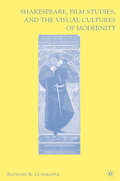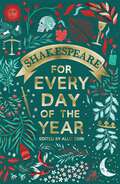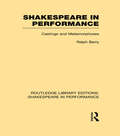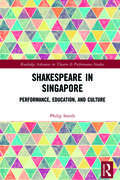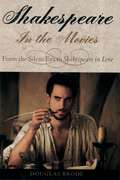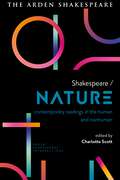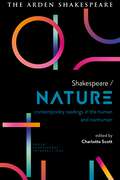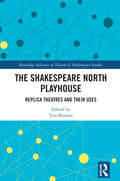- Table View
- List View
Shakespeare, Film Studies, and the Visual Cultures of Modernity
by A. GuneratneThis book is the first in-depth cultural history of cinema's polyvalent and often contradictory appropriations of Shakespearean drama and performance traditions. The author argues that these adapatations have helped shape multiple aspects of film, from cinematic style to genre and narrative construction.
Shakespeare for Every Day of the Year
by Allie EsiriFrom Allie Esiri, editor of the bestselling A Poem for Every Day of the Year and A Poem for Every Night of the Year, comes this beautiful gift anthology of Shakespeare's works.William Shakespeare wrote at least 37 plays, 154 sonnets and a handful of longer poems and you can discover them all here. Each page of this unique collection contains an extract, which might be a famous poem, quote or scene, matched to the date. Allie Esiri's introductions give her readers a new window into the work, time and life of the greatest writer in the English language. Shakespeare for Every Day of the Year is perfect for reading or sharing and brings you Shakespeare’s best-known and best-loved classics alongside lesser known extracts. Esiri’s entertaining and insightful thoughts on each entry will fill your year with wonder, laughter, wisdom and wit.
Shakespeare in Cuba: Caliban’s Books (Global Shakespeares)
by Donna Woodford-GormleyShakespeare in Cuba: Caliban’s Books explores how Shakespeare is consumed and appropriated in Cuba. It contributes to the underrepresented field of Latin American Shakespeares by applying the lens of cultural anthropophagy, a theory with Latin American roots, to explore how Cuban artists ingest and transform Shakespeare’s plays. By consuming these works and incorporating them into Cuban culture and literature, Cuban writers make the plays their own while also nourishing the source texts and giving Shakespeare a new afterlife.
Shakespeare in Performance: Castings and Metamorphoses (Routledge Library Editions: Shakespeare in Performance)
by Ralph BerryThese studies take stage history as a means of knowing the play. Half of the studies deal with casting - doubling, chorus and the crowd, the star of Hamlet and Measure for Measure. Then the transformations of dramatis personae are analyzed and The Tempest is viewed through the changing relationships of Prospero, Ariel and Caliban. Some of Shakespeare’s most original strategies for audience control are studied, such as Cordelia's asides in King Lear, Richard II’s subversive laughter and the scenic alternation of pleasure and duty in Henry IV. Performance is the realization of identity. The book draws on major productions up to 1992, just before the book was originally published.
Shakespeare in Performance: Castings and Metamorphoses (Routledge Library Editions: Shakespeare in Performance)
by Ralph BerryThese studies take stage history as a means of knowing the play. Half of the studies deal with casting - doubling, chorus and the crowd, the star of Hamlet and Measure for Measure. Then the transformations of dramatis personae are analyzed and The Tempest is viewed through the changing relationships of Prospero, Ariel and Caliban. Some of Shakespeare’s most original strategies for audience control are studied, such as Cordelia's asides in King Lear, Richard II’s subversive laughter and the scenic alternation of pleasure and duty in Henry IV. Performance is the realization of identity. The book draws on major productions up to 1992, just before the book was originally published.
Shakespeare in Singapore: Performance, Education, and Culture (Routledge Advances in Theatre & Performance Studies)
by Philip SmithShakespeare in Singapore provides the first detailed and sustained study of the role of Shakespeare in Singaporean theatre, education, and culture. This book tracks the role and development of Shakespeare in education from the founding of modern Singapore to the present day, drawing on sources such as government and school records, the entire span of Singapore's newspaper archives, playbills, interviews with educators and theatre professionals, and existing academic sources. By uniting the critical interest in Singaporean theatre with the substantial body of scholarship that concerns global Shakespeare, the author overs a broad, yet in-depth, exploration of the ways in which Singaporean approaches to Shakespeare have been shaped by, and respond to, cultural work going on elsewhere in Asia. A vital read for all students and scholars of Shakespeare, Shakespeare in Singapore offers a unique examination of the cultural impact of Shakespeare, beyond its usual footing in the Western world.
Shakespeare in Singapore: Performance, Education, and Culture (Routledge Advances in Theatre & Performance Studies)
by Philip SmithShakespeare in Singapore provides the first detailed and sustained study of the role of Shakespeare in Singaporean theatre, education, and culture. This book tracks the role and development of Shakespeare in education from the founding of modern Singapore to the present day, drawing on sources such as government and school records, the entire span of Singapore's newspaper archives, playbills, interviews with educators and theatre professionals, and existing academic sources. By uniting the critical interest in Singaporean theatre with the substantial body of scholarship that concerns global Shakespeare, the author overs a broad, yet in-depth, exploration of the ways in which Singaporean approaches to Shakespeare have been shaped by, and respond to, cultural work going on elsewhere in Asia. A vital read for all students and scholars of Shakespeare, Shakespeare in Singapore offers a unique examination of the cultural impact of Shakespeare, beyond its usual footing in the Western world.
Shakespeare in the Movies: From the Silent Era to Shakespeare in Love
by Douglas BrodeShakespeare is now enjoying perhaps his most glorious--certainly his most popular--filmic incarnation. Indeed, the Bard has been splashed across the big screen to great effect in recent adaptations of Hamlet, Henry V, Othello, Twelfth Night, Romeo and Juliet, Much Ado About Nothing, Richard II, A Midsummer Night's Dream, and of course in the hugely successful Shakespeare in Love. Unlike previous studies of Shakespeare's cinematic history, Shakespeare in the Movies proceeds chronologically, in the order that plays were written, allowing the reader to trace the development of Shakespeare as an author--and an auteur--and to see how the changing cultural climate of the Elizabethans flowered into film centuries later. Prolific film writer Douglas Brode provides historical background, production details, contemporary critical reactions, and his own incisive analysis, covering everything from the acting of Marlon Brando, Laurence Olivier, Richard Burton, and Gwyneth Paltrow, to the direction of Orson Welles, Kenneth Branagh, and others. Brode also considers the many films which, though not strict adaptations, contain significant Shakespearean content, such as West Side Story and Kurosawa's Ran and Throne of Blood. Nor does Brode ignore the ignoble treatment the master has sometimes received. We learn, for instance, that the 1929 version of The Taming of the Shrew (which featured the eyebrow-raising writing credit: "By William Shakespeare, with additional dialogue by Sam Taylor"), opens not so trippingly on the tongue--PETRUCHIO: "Howdy Kate." KATE: "Katherine to you, mug." For anyone wishing to cast a backward glance over the poet's film career and to better understand his current big-screen popularity, Shakespeare in the Movies is a delightful and definitive guide.
Shakespeare in Three Dimensions: The Dramaturgy of Macbeth and Romeo and Juliet (Focus on Dramaturgy)
by Robert BlackerIn Shakespeare in Three Dimensions, Robert Blacker asks us to set aside what we think we know about Shakespeare and rediscover his plays on the page, and as Shakespeare intended, in the rehearsal room and in performance. That process includes stripping away false traditions that have obscured his observations about people and social institutions that are still vital to our lives today. This book explores the verities of power and love in Romeo and Juliet and Macbeth, as an example of how to mine the extraordinary detail in all of Shakespeare’s plays, using the knowledge of both theatre practitioners and scholars to excavate and restore them.
Shakespeare in Three Dimensions: The Dramaturgy of Macbeth and Romeo and Juliet (Focus on Dramaturgy)
by Robert BlackerIn Shakespeare in Three Dimensions, Robert Blacker asks us to set aside what we think we know about Shakespeare and rediscover his plays on the page, and as Shakespeare intended, in the rehearsal room and in performance. That process includes stripping away false traditions that have obscured his observations about people and social institutions that are still vital to our lives today. This book explores the verities of power and love in Romeo and Juliet and Macbeth, as an example of how to mine the extraordinary detail in all of Shakespeare’s plays, using the knowledge of both theatre practitioners and scholars to excavate and restore them.
The Shakespeare Masterclasses
by Ron DestroThe Shakespeare Masterclasses is a collection of rare interviews from many of the world’s most renowned Shakespearean actors, exploring their varied approaches to topics including character creation, script analysis, acting for the stage and the camera, rehearsal, preparation, and collaboration. Ron Destro’s insightful and revealing conversations with thirteen accomplished artists provide the reader with the invaluable experience of sitting in the classroom with each of these masters. A selection of Shakespeare plays including Hamlet, The Winter’s Tale, King Lear, and The Tempest are examined to explore antithesis, line-endings, rhyme and meter, method acting, and the artistry of a good director. In addition to critical analysis of their vocation, the actors weave through personal and humorous anecdotes and favorite acting moments, and offer useful movement and vocal exercises. This book offers a lens into the creative process of world-acclaimed actors, to expose an abundance of tips, tools, and fascinating stories about the acting profession that will be of crucial interest to acting students, directors, drama teachers, Shakespeare performance scholars, and general theatre fans more broadly.
The Shakespeare Masterclasses
by Ron Song DestroThe Shakespeare Masterclasses is a collection of rare interviews from many of the world’s most renowned Shakespearean actors, exploring their varied approaches to topics including character creation, script analysis, acting for the stage and the camera, rehearsal, preparation, and collaboration. Ron Destro’s insightful and revealing conversations with thirteen accomplished artists provide the reader with the invaluable experience of sitting in the classroom with each of these masters. A selection of Shakespeare plays including Hamlet, The Winter’s Tale, King Lear, and The Tempest are examined to explore antithesis, line-endings, rhyme and meter, method acting, and the artistry of a good director. In addition to critical analysis of their vocation, the actors weave through personal and humorous anecdotes and favorite acting moments, and offer useful movement and vocal exercises. This book offers a lens into the creative process of world-acclaimed actors, to expose an abundance of tips, tools, and fascinating stories about the acting profession that will be of crucial interest to acting students, directors, drama teachers, Shakespeare performance scholars, and general theatre fans more broadly.
Shakespeare, The Movie II: Popularizing the Plays on Film, TV, Video and DVD
by Richard Burt Lynda E. BooseFollowing on from the phenomenally successful Shakespeare, The Movie, this volume brings together an invaluable new collection of essays on cinematic Shakespeares in the 1990s and beyond. Shakespeare, The Movie II:*focuses for the first time on the impact of postcolonialism, globalization and digital film on recent adaptations of Shakespeare;*takes in not only American and British films but also adaptations of Shakespeare in Europe and in the Asian diapora;*explores a wide range of film, television, video and DVD adaptations from Almereyda's Hamlet to animated tales, via Baz Luhrmann, Kenneth Branagh, and 1990s' Macbeths, to name but a few;*offers fresh insight into the issues surrounding Shakespeare on film, such as the interplay between originals and adaptations, the appropriations of popular culture, the question of spectatorship, and the impact of popularization on the canonical status of "the Bard."Combining three key essays from the earlier collection with exciting new work from leading contributors, Shakespeare, The Movie II offers sixteen fascinating essays. It is quite simply a must-read for any student of Shakespeare, film, media or cultural studies.
Shakespeare, The Movie II: Popularizing the Plays on Film, TV, Video and DVD
by Richard Burt Lynda E. BooseFollowing on from the phenomenally successful Shakespeare, The Movie, this volume brings together an invaluable new collection of essays on cinematic Shakespeares in the 1990s and beyond. Shakespeare, The Movie II:*focuses for the first time on the impact of postcolonialism, globalization and digital film on recent adaptations of Shakespeare;*takes in not only American and British films but also adaptations of Shakespeare in Europe and in the Asian diapora;*explores a wide range of film, television, video and DVD adaptations from Almereyda's Hamlet to animated tales, via Baz Luhrmann, Kenneth Branagh, and 1990s' Macbeths, to name but a few;*offers fresh insight into the issues surrounding Shakespeare on film, such as the interplay between originals and adaptations, the appropriations of popular culture, the question of spectatorship, and the impact of popularization on the canonical status of "the Bard."Combining three key essays from the earlier collection with exciting new work from leading contributors, Shakespeare, The Movie II offers sixteen fascinating essays. It is quite simply a must-read for any student of Shakespeare, film, media or cultural studies.
Shakespeare / Nature: Contemporary Readings in the Human and Non-human (Arden Shakespeare Intersections)
by Lucy Munro Professor Sonia Massai Dr Farah Karim Cooper Professor Gordon McMullanShakespeare / Nature sets new agendas for the study of nature in Shakespeare's work. Offering a rich exploration of the intersections between the human and non-human worlds, the chapters focus on the contested and persuasive language of nature, both as organic matter and cultural conditioning.Rooted in close textual analysis and historical acuity, this collection addresses Shakespeare's works through the many ways in which 'nature' performs, as a cultural category, a moral marker and a set of essential conditions through which the human may pass, as well as affect. Addressing the complex conditions of the play worlds, the chapters explore the assorted forms through which Shakespeare's nature makes sense of its narratives and supports, upholds or contests its story-telling. Over the course of the collection, the contributors examine plays including Macbeth, Julius Caesar, The Tempest, The Taming of the Shrew, Othello, Love's Labour's Lost, Hamlet, Timon of Athens and many more. They discuss them through the various lenses of philosophy, historicism, psychoanalysis, gender studies, cosmography, geography, sexuality, linguistics, environmentalism, feminism and robotics, to provide new and nuanced readings of the intersectional terms of both meaning and matter.Approaching 'nature' in all its multiplicity, this collection sets out to examine the divergent and complex ways in which the human and non-human worlds intersect and the development of a language of symbiosis that attempts to both control and create the terms of human authority. It offers an entirely new approach to the subject of nature, bringing together disparate methods that have previously been pursued independently to offer a shared investment in the intersections between the human and non-human worlds and how these discourses shape and condition the emotional, organic, cultural and psychological landscapes of Shakespeare's play worlds.
Shakespeare / Nature: Contemporary Readings in the Human and Non-human (Arden Shakespeare Intersections)
by Lucy Munro Professor Sonia Massai Dr Farah Karim Cooper Professor Gordon McMullanShakespeare / Nature sets new agendas for the study of nature in Shakespeare's work. Offering a rich exploration of the intersections between the human and non-human worlds, the chapters focus on the contested and persuasive language of nature, both as organic matter and cultural conditioning.Rooted in close textual analysis and historical acuity, this collection addresses Shakespeare's works through the many ways in which 'nature' performs, as a cultural category, a moral marker and a set of essential conditions through which the human may pass, as well as affect. Addressing the complex conditions of the play worlds, the chapters explore the assorted forms through which Shakespeare's nature makes sense of its narratives and supports, upholds or contests its story-telling. Over the course of the collection, the contributors examine plays including Macbeth, Julius Caesar, The Tempest, The Taming of the Shrew, Othello, Love's Labour's Lost, Hamlet, Timon of Athens and many more. They discuss them through the various lenses of philosophy, historicism, psychoanalysis, gender studies, cosmography, geography, sexuality, linguistics, environmentalism, feminism and robotics, to provide new and nuanced readings of the intersectional terms of both meaning and matter.Approaching 'nature' in all its multiplicity, this collection sets out to examine the divergent and complex ways in which the human and non-human worlds intersect and the development of a language of symbiosis that attempts to both control and create the terms of human authority. It offers an entirely new approach to the subject of nature, bringing together disparate methods that have previously been pursued independently to offer a shared investment in the intersections between the human and non-human worlds and how these discourses shape and condition the emotional, organic, cultural and psychological landscapes of Shakespeare's play worlds.
The Shakespeare North Playhouse: Replica Theatres and Their Uses (ISSN)
by Tim KeenanThis collection celebrates the opening of the Shakespeare North Playhouse (SNP). After discussion of its genesis and development by four people pivotal to its progress at different stages of the project, this book explores different aspects of the SNP’s purpose and functions across three broad categories: buildings and spaces, practices and performance, and community arts and education. Various chapters offer answers to fundamental questions about replica theatres, including: Why do we build them? What do they do? How do we use them? In the course of these discussions, the purposes, potential, and programming of the SNP are discussed in relation to other Globe-type replicas in the UK and beyond. Contributors to this collection analyse key academic and practice-based concerns within their fields of expertise connected to the use (and misuse) of replica theatres to suggest the ways in which they can be used to drive research and practice in contemporary Shakespearean performance, connect with young people, and serve local communities.This book will appeal to academics, students, and practitioners interested in historical and contemporary approaches to Shakespeare in the fields covered. It should also appeal to general readers with an interest in the topics, particularly in Merseyside and the North-West region.
The Shakespeare North Playhouse: Replica Theatres and Their Uses (ISSN)
This collection celebrates the opening of the Shakespeare North Playhouse (SNP). After discussion of its genesis and development by four people pivotal to its progress at different stages of the project, this book explores different aspects of the SNP’s purpose and functions across three broad categories: buildings and spaces, practices and performance, and community arts and education. Various chapters offer answers to fundamental questions about replica theatres, including: Why do we build them? What do they do? How do we use them? In the course of these discussions, the purposes, potential, and programming of the SNP are discussed in relation to other Globe-type replicas in the UK and beyond. Contributors to this collection analyse key academic and practice-based concerns within their fields of expertise connected to the use (and misuse) of replica theatres to suggest the ways in which they can be used to drive research and practice in contemporary Shakespearean performance, connect with young people, and serve local communities.This book will appeal to academics, students, and practitioners interested in historical and contemporary approaches to Shakespeare in the fields covered. It should also appeal to general readers with an interest in the topics, particularly in Merseyside and the North-West region.
Shakespeare / Not Shakespeare
by Christy Desmet Natalie Loper Jim CaseyThis essay collection addresses the paradox that something may at once “be” and “not be” Shakespeare. This phenomenon can be a matter of perception rather than authorial intention: audiences may detect Shakespeare where the author disclaims him or have difficulty finding him where he is named. Douglas Lanier’s “Shakespearean rhizome,” which co-opts Deleuze and Guattari’s concept of artistic relations as rhizomes (a spreading, growing network that sprawls horizontally to defy hierarchies of origin and influence) is fundamental to this exploration. Essays discuss the fine line between “Shakespeare” and “not Shakespeare” through a number of critical lenses—networks and pastiches, memes and echoes, texts and paratexts, celebrities and afterlives, accidents and intertexts—and include a wide range of examples: canonical plays by Shakespeare, historical figures, celebrities, television performances and adaptations, comics, anime appropriations, science fiction novels, blockbuster films, gangster films, Shakesploitation and teen films, foreign language films, and non-Shakespearean classic films.
Shakespeare / Not Shakespeare
by Christy Desmet Natalie Loper Jim CaseyThis essay collection addresses the paradox that something may at once “be” and “not be” Shakespeare. This phenomenon can be a matter of perception rather than authorial intention: audiences may detect Shakespeare where the author disclaims him or have difficulty finding him where he is named. Douglas Lanier’s “Shakespearean rhizome,” which co-opts Deleuze and Guattari’s concept of artistic relations as rhizomes (a spreading, growing network that sprawls horizontally to defy hierarchies of origin and influence) is fundamental to this exploration. Essays discuss the fine line between “Shakespeare” and “not Shakespeare” through a number of critical lenses—networks and pastiches, memes and echoes, texts and paratexts, celebrities and afterlives, accidents and intertexts—and include a wide range of examples: canonical plays by Shakespeare, historical figures, celebrities, television performances and adaptations, comics, anime appropriations, science fiction novels, blockbuster films, gangster films, Shakesploitation and teen films, foreign language films, and non-Shakespearean classic films.
Shakespeare on Film
by Judith R. BuchananFrom the earliest days of the cinema to the present, Shakespeare has offered a tempting bank of source material than the film industry has been happy to plunder. Shakespeare on Film deftly examines an extensive range of films that have emerged from the curious union of an iconic dramatist with a medium of mass appeal. The many films Buchanan studies are shown to be telling indicators of trends in Shakespearean performance interpretation, illuminating markers of developments in the film industry and culturally revealing about broader influences in the world beyond the movie theatre. As with other titles from the Inside Film series, the book is illustrated throughout with stills. Each chapter concludes with a list of suggested further reading in the field.
Shakespeare on Film
by Judith R. BuchananFrom the earliest days of the cinema to the present, Shakespeare has offered a tempting bank of source material than the film industry has been happy to plunder. Shakespeare on Film deftly examines an extensive range of films that have emerged from the curious union of an iconic dramatist with a medium of mass appeal. The many films Buchanan studies are shown to be telling indicators of trends in Shakespearean performance interpretation, illuminating markers of developments in the film industry and culturally revealing about broader influences in the world beyond the movie theatre. As with other titles from the Inside Film series, the book is illustrated throughout with stills. Each chapter concludes with a list of suggested further reading in the field.
Shakespeare on Film
by Maurice HindleAn approachable guide to Shakespeare on film, this book establishes the differences between stage and screen. It covers the history of Shakespeare on the screen since 1899, and discusses various modes and conventions of adaptations. Thoroughly updated to include the most recent films, for instance Joss Whedon's 2013 Much Ado About Nothing, it also explores the latest technology, such as DVD and Blu-ray, as well as live stage-to-screen productions. It also includes an exclusive interview with filmmaker John Wyver, discussing his own adaptations for the small screen.
Shakespeare on Film
by Maurice HindleAn approachable guide to Shakespeare on film, this book establishes the differences between stage and screen. It covers the history of Shakespeare on the screen since 1899, and discusses various modes and conventions of adaptations. Thoroughly updated to include the most recent films, for instance Joss Whedon's 2013 Much Ado About Nothing, it also explores the latest technology, such as DVD and Blu-ray, as well as live stage-to-screen productions. It also includes an exclusive interview with filmmaker John Wyver, discussing his own adaptations for the small screen.
Shakespeare on Theatre: A Critical Look at His Theories and Practices
by Robert CohenIn Shakespeare on Theatre, master acting teacher Robert Cohen brilliantly scrutinises Shakespeare's implicit theories of acting, paying close attention to the plays themselves and providing a wealth of fascinating historical evidence. What he finds will surprise scholars and actors alike – that Shakespeare's drama and his practice as an actor were founded on realism, though one clearly distinct from the realism later found in Stanislavski. Shakespeare on Acting is an extraordinary introduction to the way the plays articulate a profound understanding of performance and reflect the life and times of a uniquely talented theatre-maker.
